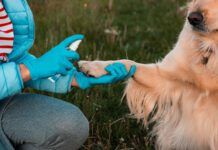By Gregory L. Tilford
Are you among the millions of people who set out into the great outdoors every year? If so, are you familiar with Urtica? If not, you certainly should be. Collectively known as nettle, these plants inhabit drainage ditches, stream banks, and other moist soils in North America and throughout the Northern Hemisphere.
Nettle deserves your attention. In fact, it actually demands your attention. Even the slightest brush of skin against the stems or leaves of the plant will immediately result in a painful sting. Tiny, hollow needles line the stem and leaf margins of the plant, each containing a combination of formic acid and antigenic proteins. These toxins are held under a slight pressure, so when a person’s skin comes in contact with the tiny needles, the venom is actually injected into the outer layers of skin, causing a burning rash of tiny blisters.

Fortunately, the discomfort is generally short-lived. The chemicals that cause nettle’s sting dissipate quickly when exposed to air, and the rash usually disappears within a couple of hours. In fact, complete drying or cooking of the leafy greens will neutralize these compounds altogether, allowing dogs and their caregivers to enjoy its delicious flavor and powerful medicine. And for those who do not wish to brave foreboding incursions into unruly patches of stinging weeds, don’t despair; nettle is accessible to everyone, in certified organic, dried (and sting-free), bulk-bin form at your local health food store.
Nettle is extremely nourishing. One hundred grams of the dried leaves may contain as much as 30.4 g (that’s 30 percent by weight!) of crude protein, 2,970 mg of calcium, 680 mg of phosphorus, 32.2 mg of iron, 650 mg of magnesium, 20.2 mg beta-carotene, and 3,450 mg of potassium. Also present are vitamins A, C, D, and B-complex, all in a highly palatable form that can be effectively assimilated into the body without adding stress upon the liver, kidneys, or digestive tract. This makes nettle an excellent “green food” supplement for dogs who need extra trace minerals and vitamins in their diets, but not in huge, multi-vitamin doses, such as those on a well-balanced home-prepared diet.
In addition, because nettle is rich in gut-cleansing fiber and antioxidant chlorophyll, it a good choice for dogs that are prone to chronic digestive disorders, systemic toxicity, or urinary tract problems. The dried herb can be sprinkled directly onto the animals’ food, ½ tsp. for each pound of food fed.
Nettle for the eyes and skin
Many of the herbal eye rinse preparations found on store shelves contain extracts of a plant called “eyebright” (Euphrasia species). Although eyebright is an excellent anti-inflammatory agent for the eyes, much of it is harvested from the wild. A growing concern among ecology-minded herbalists suggests that wild stands of eyebright may not be able to sustain the impacts of the burgeoning herb market much longer. Therefore, if you choose to utilize any product that contains eyebright, please make sure it comes from cultivated sources. Or, as an earth-friendly alternative to wild harvested eyebright, use nettle instead.
Nettle is one of the first herbs I reach for when a need arises for a soothing, anti-inflammatory eye rinse. Start by making a good, strong nettle tea. Stuff a tea ball as full as you can with dried nettle leaves, then steep in a quart of near-boiling water until the tea is completely cool. Strain it through a paper coffee filter.
To make the final eye rinse, mix a few tablespoons of the nettle tea with 8-12 ounces of buffered saline solution (the stuff used for rinsing contact lenses, available at any supermarket). To apply, hold your companion’s head to one side and pour a small quantity across the eye, making certain that it reaches affected areas.
If nettle tea is not your bag, an alcohol-based nettle leaf tincture (available at health food stores) can be used instead. Simply mix 10-12 drops of the tincture into one ounce of saline. Don’t worry about the alcohol; at this mixing ratio it will be very dilute – a harmless one percent or less. Apply the tincture/saline rinse the same way as mentioned above, one to three times per day until the redness is gone.
These preparations will work as a gentle astringent to shrink swollen tissues and bring soothing relief to mild cases of conjunctivitis or eye irritation that are due to blowing dust or too much dry wind in the eyes during car rides. If a bacterial or fungal infection is suspected, a few drops of Oregon Grape (Mahonia aquifolium) or certified organic goldenseal root (Hydrastis canadensis) tincture can be added to the above formulas for antimicrobial support.
Nettle leaf tea is also an excellent skin and coat rinse that will nourish your animal’s fur and provide symptomatic relief for itchy skin and fleabites. Simply make strong tea, allow it to cool, and pour over your dog until he is thoroughly soaked. Allow your companion to drip-dry; don’t waste precious nettle tea by wiping it off with a towel!
Nettle for allergy
Although researchers remain puzzled about how nettle works in this capacity, many herbalists who suffer from seasonal allergies have found that nettle leaf helps lessen their symptoms if taken on a regular basis just before and throughout hayfever season. In a recent study involving 69 patients who suffer from allergic rhinitis, 58 percent found relief after taking a freeze-dried preparation of the leaf. Similarly, many of the holistic veterinarians I work with have seen positive results when nettle is used in the same capacity for dogs.
There are a number of theories that could explain nettle’s success at treating allergies. The anti-allergenic activities of nettle may be attributable to its histamine compounds, which may serve to mimic or somehow slow the release of histamines that are naturally produced by the allergy sufferer’s body. Or they may trigger an immune response that serves to strengthen the body system proactively, so the body is better prepared to deal with the inevitable onslaught of allergens that come when hayfever season begins.
For animals with predictable, seasonal occurrences of allergies, dietary supplementation with dried nettle leaf may help. Use one-half teaspoon of the dried herb, added to each cup of food at mealtime.
Nettle for urinary dysfunction
Many herbalists believe that the roots of nettle may be useful in the treatment of prostate enlargement, especially at early onset of the disorder. Although swollen prostate is not as common in animals as it is in humans, it can happen. In my experiences with dogs, chronic or acute urinary infections, mucous discharge, inexplicable ejaculation, or urinary incontinence may accompany prostate enlargement. The problem may be secondary to injuries of the urinary tract that have resulted from stones, neutering, or other trauma.
Prostatic adenoma is a degenerative enlargement of the glandular part of the prostate that typically results in frequent urination during the night. In a study conducted with human subjects who had mild cases or early onset of this disorder, the fluid extract (tincture) of nettle root was found to reduce the duration and volume of urine retention, and thus the need to urinate throughout the night was reduced as well.
The active constituent in this case is thought to be Beta-sitosterol, a phytosterol known to possess mild anti-inflammatory actions. Although this action is not likely to reduce the formation of scar tissue within the urinary tract and prostate, it may help relieve symptoms through reduction of swelling in surrounding tissues. Given the safety of this herb and functional similarities between the prostates of animals and humans, nettle is certainly worth a try in dogs.
Enjoyable harvest
If you are bold enough to harvest nettles yourself, do so before the plants bloom. The younger the plants are the better they will be. Mature plants become tough and bitter, and begin developing tiny crystalline particles, called cystoliths in their leaf tissues that can be irritating to mucous membranes in the urinary tract.
Wear long sleeves and gloves (if you forget, you’re in for painful lesson) and harvest from clean, herbicide-free areas that are least 100 feet from any roadways. After gathering, you can boil the greens and serve them as you would spinach (excellent with garlic, lemon, and butter) or you can spread them onto clean newspapers to dry. Be sure they are in a well-ventilated, sunlight-free location until they are crispy-dry.
If by chance a leaf or stem manages to sneak under your shirt sleeve during harvest, try this: grasp a piece of the stem and squeeze some of the nettle juice onto the affected area. The stem juice is rich in lecithin, which will sometimes antidote the sting.
Just remember; if you don’t introduce yourself to nettle, it may introduce itself to you. Ouch!
Greg Tilford is a well-known veterinary herbalist, lecturer, and author. He serves as a consultant and formulator to hundreds of holistic veterinarians throughout the world, and is CEO of Animal’s Apawthecary, a company that develops herbal products specifically for use in animals. He is author of four books on herbs, including All You Ever Wanted to Know About Herbs for Pets (Bowtie, 1999), which he co-authored with his wife, Mary.






Can I use nettles and eyebright allergy and immune support “made by herbs for kids”for my chihuahua for allergies